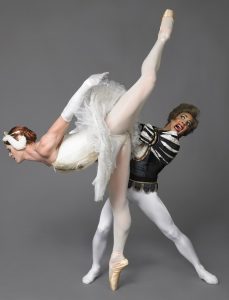Vancouver: Summer 2015 - Vancouver Ballet Society
- Home
- City Reports 2015 - 2019
- Vancouver: Summer 2015

by Kaija Pepper
Louise Lecavalier is a true diva of dance, a small powerhouse who blazes across the stage and brings audiences to their feet. She performs in such a frank manner it looks tossed off, though the richly textured array of force and momentum she embodies is the result of a lifetime of dedication. Lecavalier, punk darling of the eighties and nineties, is now 57 and a mother of twin teenagers, but in So Blue — performed here in January at the PuSh Festival — the Montreal artist is still so darn cool, wearing sports pants and hoody, with an angular, blonde haircut.
So Blue, which Lecavalier choreographed, is a duet with Frédéric Tavernini, who is onstage partnering her for about half the time. A calm bear of a man, he was too sensible, perhaps, to dance for a whole hour in high gear, as Lecavalier does. The show, which has been seen all over (reviewed at its 2013 premiere in Dance International by Linde Howe-Beck), is a little unbalanced structurally, a little repetitive, and so forth and so on — but the audience at the Wong Experimental Theatre roared its approval, and I was happy to add my roar, too.
A few nights later, there was more roaring, this time at the sold-out Queen Elizabeth Theatre, filled from the orchestra to the upper gods for a group of flamboyant Russian-styled ballerinas and their gallant partners. Les Ballets Trockadero de Monte Carlo, the New York company of 15 men, presented a warm-hearted, well-danced (grand jetés, fouettés and all) satire on the foibles and conventions of classical ballet.
The Trocks were founded in 1974; then, men dancing en travesti in tutus and pointe shoes carried shock value. Today, not so much. The Trocks, however, have more going for them than mere cross-dressing. Olga Supphosova, who “made her first public appearance in a KGB lineup,” Nina Immobilashvili, “the Great Terror of the international ballet world” and Sergey Legupski, one of five Legupski Brothers, are just three of the funny, very human characters created by the international artists of the company (Robert Carter, Alberto Pretto and Giovanni Goffredo in the roles above).
A highlight of Chutzpah! festival at the Rothstein Theatre was Los Angeles’ BODYTRAFFIC, who brought a mixed repertory that included Kyle Abraham’s Kollide. The New York-based Abraham is popular these days, and Kollide (2013) shows why: his movement, for five dancers, is subtle, sensual and musical, building its own logic of twists and curves.
Also at Chutzpah!,Glory, by Vancouver’s Shay Kuebler, featured a group of six playing out action movie clichés. Glory was glimpsed, but quietly, in a few moments when Kuebler simply danced, unburdened with story. His compact body spun and lunged with ease and elegance in a relaxed vocabulary influenced by hip-hop and martial arts.
Yet another fest — the Vancouver International Dance Festival — brought its annual gift: free pre-show shows. Benjamin Kamino (a curator with Toronto’s Dancemakers) presented his provocative solo, Nudity. Desire, first seen here in 2011. In this iteration, Kamino lounged afterward in the Roundhouse exhibition hall, fully nude, fully comfortable, somehow innocent and edgy at the same time.
Another free show, Tao Te by Hungarian Ferenc Fehér, was an absurdist encounter between two men in dark suits (Fehér and Ákos Dózsa), who gobbled their picnic before engaging in choreographic skips, hops and falls in relationship to each other, or not, with apparent passive or aggressive intention.
On the Roundhouse mainstage, Montreal’s Benoît Lachambre presented his Snakeskins, a secretive, jokey “fake solo,” with the often masked Lachambre supported onstage by performer Daniele Albanese (masked throughout) and musician Hahn Rowe. The dark, muscular piece featured a hard body that rather tediously jerked and convulsed. Yet the evening felt redeemed by the whimsical ending: Lachambre fluttered and swayed while a stagehand entered and began to shut things down, and, finally, the audience shuffled out, which seemed what Lachambre was directing us to do, though he was still dancing.
Headlining the international festival, Japan’s Dairakudakan brought 22 white-painted bodies to the upscale Playhouse for Mushi no Hoshi — Space Insect. The sci-fi horror story was choreographed in 2014 by artistic director Akaji Maro, who studied under Tatsumi Hijikata, a founder of butoh. The troupe presented an old-school gender-based division of labour: the men were bald, cast as the aggressive insects (at one point, their heads were covered by upside down kettles, creating blind, long-snouted faces); the women, their hair in buns or covered with short, girlish wigs, were the victims, including one Sacrificed Girl.
A quick preview to end: in Vital Few, a work-in-progress by Vancouver’s up-and-coming 605 Collective, all eight dancers stood strong and individual within the ensemble, including choreographers Lisa Gelley and Josh Martin. The opening — in silence — was concise, subtle and highly musical, boding well for the premiere at next year’s festival.

